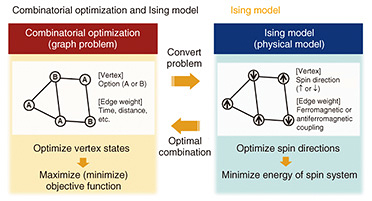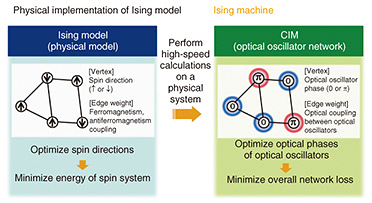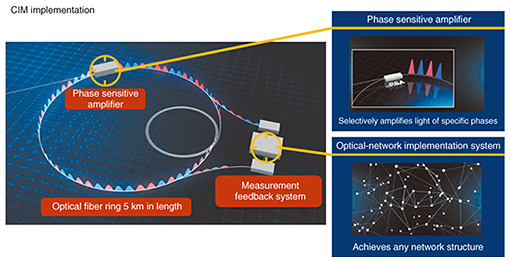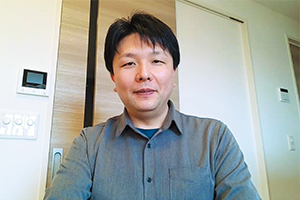 |
|
|
|
|
|
Rising Researchers Vol. 21, No. 8, pp. 11–15, Aug. 2023. https://doi.org/10.53829/ntr202308ri1 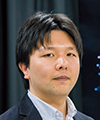 Applying Optical Oscillator Networks to Diverse Problems as the First Step to Information Processing Systems of the FutureAbstractIn the field of computer science requiring advanced information processing, an algorithm called simulated annealing is widely used to derive optimal solutions from a combination of numerous options in a network. However, in an era in which increasingly complex networks are coming to be constructed, any approach based on conventional methods is reaching its limits. To break down this wall, information processing techniques that can be applied to a variety of physical systems are being proposed. In this interview, we talked with NTT Distinguished Researcher Takahiro Inagaki about his research on new computing systems using optical technologies. Keywords: coherent Ising machine, optical oscillator, spiking neural network Solving combinatorial optimization problems with coherent Ising machine technology using light—Dr. Inagaki, please explain the nature of combinatorial optimization problems that have become a key issue in computing today. A combinatorial optimization problem searches for a solution applicable to the current objective from a combination of multiple options. For example, “Should I turn left or right?” is a simple problem having only two options. However, the number of combinations increases exponentially as the number of options increases, resulting in a massively large number of combinations. As a result, deriving the best answer from among all combinations is extremely difficult even with today’s digital computers. To solve such a difficult problem, algorithms such as simulated annealing that derive approximate solutions at high speed using heuristic techniques have come to be used. Simulated annealing is a very powerful algorithm, but as the network structure of options in a combinatorial optimization problem becomes increasingly large and complex, the computing time and energy consumption needed for obtaining approximate solutions with good results have become issues of concern. In recent years, the Ising model has been attracting attention as a technique for solving such combinatorial optimization problems at high speed with high accuracy. The Ising model is a network model featuring two types of states (spins), one in the upward direction and the other in the downward direction, similar to the S-pole and N-pole of a magnet. This model makes it possible to solve a combinatorial optimization problem by replacing two options in the problem with upward spin and downward spin and determining the optimal relationship among options through spin interaction (Fig. 1). Techniques for solving combinatorial optimization problems on a physical system based on this Ising model have been proposed such as a quantum annealing machine based on a network of superconducting qubits.
—What is a physical system that actually uses the Ising model? We have developed an information processing system based on a new mechanism called a coherent Ising machine (CIM) by representing the Ising model using a network of optical oscillators. This computer divides output light into two states—0 phase and π phase—by using a special optical oscillator called a degenerate optical parametric oscillator (DOPO). Replacing these two states with spin directions achieves the Ising model using optical oscillators (Fig. 2).
This is a computer based on a new principle different from the simulated annealing or quantum annealing. A key feature of the CIM is that a network of same-phase or opposite-phase optical coupling can be set up among all optical oscillators. Light has the property by which “energy is increased when same-phase light couples and decreased when opposite-phase light couples.” The CIM naturally selects the 0-phase and π-phase states of all optical oscillators so that the energy loss arising from optical coupling in the entire network is small, which means, in terms of the Ising model, that spin directions change into states in which overall energy is low. By replacing this with combinatorial optimization problems, we can derive combinations of options producing excellent results. There has already been much research on solving combinatorial optimization problems using physical systems and many proposals have been made, but a major issue here is how to prepare many uniform physical elements and implement a complex network among those elements. For example, in quantum annealing technology, a network is created by wiring together an arrangement of superconducting qubits, but variation in the quality of each element and spatial constraints in wiring have been problems in implementing a complex network structure. NTT’s CIM, on the other hand, solves those problems in generating a network of many uniform optical oscillators by using time-domain multiplexing in a single optical circuit. In this way, running time-shifted optical pulses in a ring of optical fiber much like running trains on the Yamanote loop line in Tokyo makes it possible to create multiple optical oscillators and implement many uniform optical oscillators. Multiplexing in the time domain also makes individual measurements unnecessary since a single detector can be used to measure different optical oscillators in each time slot. A complex network can therefore be created based on the measurement results of a detector and feedback system. Using this technology, we have implemented a large-scale system having a maximum of 100,000 optical oscillators within an optical fiber ring having a total length of 5 km (Fig. 3). At present, we are searching for solutions of combinatorial optimization problems using this technology, which we expect will find use in a variety of fields such as drug discovery and radio frequency allocation.
—What is your current line of research? Now, using the large-scale optical oscillator network that we have achieved in our CIM research as a foundation to work from, I am actively engaged in the research of spiking neural networks (SNNs) based on artificial optical neurons. From the beginning, I have been deeply interested in biological academic fields seeking to answer the question “What is the mechanism of the human brain?” Consequently, in many discussions with my fellow researchers, I and my collaborators wondered whether the spiking of nerve cells in the brain (firing phenomenon) could be simulated by applying DOPO characteristics using our CIM. Inspired by this idea, I began my research. One advantage of using DOPOs in this research is that the firing mode of artificial optical neurons can be freely selected by changing the pump intensity of the optical oscillators. In addition to the two types of nerve-cell firing modes called Class-I and Class-II that I am focused on in my present research, a variety of firing modes exist in the nerve cells of living organisms, and I believe that those modes could interact to perform advanced information processing. If we can use DOPOs to reproduce the firing modes of complex nerve cells in the brain and construct a network of diverse artificial optical neurons, we should expect to have a major advantage in understanding the mechanism of information processing in the brain. We have so far conducted network experiments using a maximum of 256 artificial optical neurons. In these experiments, we began by observing basic artificial-neuron firing dynamics and then moved on to observing spontaneous synchronized phenomena in the network and synchronous/asynchronous coexisting states called chimera states, for example. —What is your future outlook for optical SNN research? As the next step in our research, we are expanding the scale of our optical SNN by constructing experimental equipment for 10,000 artificial optical neurons. To conduct tests with general machine-learning applications in mind, using 256 artificial optical neurons is still insufficient, so we are aiming for a 10,000-neuron network as our next target. In recent years, there has been much research on applying image recognition based on artificial NNs and information processing such as time-series prediction to SNN models, so I would like to implement applications like these in physical systems using our network of artificial optical neurons. To completely imitate the human brain, I believe that the ultimate target is to achieve a large-scale neural network of from 10 billion to 100 billion neurons. But first of all, I would like to clarify the role that diversity in the neuron-firing model in our research plays in neural information processing. From here on, to achieve information processing that is even closer to the human brain, I will take up the challenge of incorporating knowledge of various firing modes including Class-I and Class-II modes in an optical SNN to clarify the information processing model of our brains.
To researchers who take a leap into the unknown and break new ground—What is your impression of NTT Basic Research Laboratories where you currently work? I think the image that “a corporate research laboratory conducts research and development along designated themes” is widely fixed in people’s minds. However, NTT Basic Research Laboratories that I belong to, despite being a corporate research laboratory, enables researchers to choose research themes with a very high degree of autonomy. At our laboratories, we are conducting a wide range of research such as quantum information technology, on-chip optical circuits, and sensing-ware using bioelectrodes. I feel that this support for research diversity reflects, in the end, the autonomy given to researchers in their selection of research themes. Although each research group has a direction to some extent, I believe that NTT Basic Research Laboratories is a place where a researcher who can clearly explain his or her reasons for wanting to pursue a new research theme will receive full backing in launching that research. Research can provide much satisfaction once you have achieved your goal, but most of the work along the way can be hard and painful. This is why I think that the answer to the question “Are the research goals in line with the researcher’s own motivation?” can greatly affect the quality of the final research results. In this regard, I consider that NTT Basic Research Laboratories, which undertakes basic research while respecting autonomy in research themes, has a rare approach to research in relation to other corporate research laboratories. I also feel that the presence of many theorists in our laboratories is a great advantage. While many experiments are needed to connect technology from basic research to development, it is not unusual in our research for a single idea from a distinguished theorist to bring about a dramatic breakthrough and solve difficult problems in our experiments. In my group, persons working on theory sit with those conducting experiments in the same office, which enables us to discuss the data that we have obtained and exchange feedback on that very day thereby speeding up our experiments. Here, a theorist can predict more appropriate parameters from experimental results and an experimenter can reflect that prediction in the next experiment. This type of feedback loop is very encouraging. I think of it as a lighthouse whose beacon illuminates the path that we should be taking, and I feel that it is simply the greatest strength of NTT Basic Research Laboratories. —Dr. Inagaki, please leave us with a message for researchers, students, and business partners. For me, the real pleasure of research is the moment that I become the first to set foot in an area that no one knows about. When moving forward with my research, I feel as if a line is drawn out in front of me, and I love the fear and elation that I feel when venturing into pitch-black territory unexplored by mankind on the other end of that line. Ninety percent of the time, there is a cliff ahead that I fall off of, but on the other hand, there have been any number of times that I have entered into new ground. The key to success here is to be resolute in researching what you yourself think is interesting even if you should fail. This kind of trial-and-error environment is sufficiently rooted at NTT laboratories, and I feel very fortunate to be able to conduct my research in such an environment every day. Making preparations thinking that it’s OK to fail and taking a step forward if it’s pitch black ahead, or in other words, repeating a cycle of falling and getting up again is something that I would like to continue as a researcher while I’m still alive. Additionally, there have been many cases in recent years of new research themes rising up at the boundaries of different research fields. For example, research of optical SNNs that I am now working on spans a broad range of research fields such as optics, brain science, and computer science, so I feel that it’s research that cannot be handled by only one person. Under these conditions, I feel that being able to say “Could you help me?” to someone with the expertise that you need is absolutely essential to breaking through barriers. At present, I receive the cooperation of many individuals not only inside the company but outside the company too. The diversity of specialized fields in a researcher’s network can be a great source of strength, so going forward, I would like to continue to be engaged in research that even researchers in other research fields find interesting. I would be glad to hear from anyone reading this article having interest in our research, and I look forward to taking on the challenges of new research fields together. ■Interviewee profileTakahiro Inagaki received his Ph.D. in engineering science from the Graduate School of Engineering, Tohoku University in 2012 and entered NTT in the same year. He has been a distinguished researcher since 2019. He is a member of the Physical Society of Japan (JPS) and the Japan Society of Applied Physics (JSAP). He received the Young Scientist Presentation Award from the JSAP in 2015, the Invention Award from the President of NTT in 2016, NTT Science and Core Technology Laboratory Group Director Award (Best Press Release) in 2018, and NTT Basic Research Laboratories Director Award (Achievement Award) in 2022. He is currently engaged in the research of information processing using quantum optics and quantum electronics. |
|









